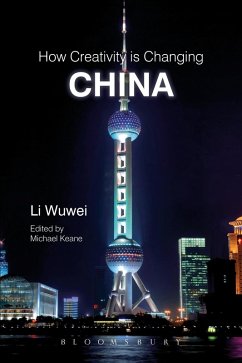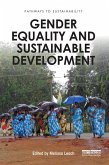Li Wuwei
How Creativity is Changing China (eBook, ePUB)
19,95 €
19,95 €
inkl. MwSt.
Sofort per Download lieferbar

10 °P sammeln
19,95 €
Als Download kaufen

19,95 €
inkl. MwSt.
Sofort per Download lieferbar

10 °P sammeln
Jetzt verschenken
Alle Infos zum eBook verschenken
19,95 €
inkl. MwSt.
Sofort per Download lieferbar
Alle Infos zum eBook verschenken

10 °P sammeln
Li Wuwei
How Creativity is Changing China (eBook, ePUB)
- Format: ePub
- Merkliste
- Auf die Merkliste
- Bewerten Bewerten
- Teilen
- Produkt teilen
- Produkterinnerung
- Produkterinnerung

Bitte loggen Sie sich zunächst in Ihr Kundenkonto ein oder registrieren Sie sich bei
bücher.de, um das eBook-Abo tolino select nutzen zu können.
Hier können Sie sich einloggen
Hier können Sie sich einloggen
Sie sind bereits eingeloggt. Klicken Sie auf 2. tolino select Abo, um fortzufahren.

Bitte loggen Sie sich zunächst in Ihr Kundenkonto ein oder registrieren Sie sich bei bücher.de, um das eBook-Abo tolino select nutzen zu können.
This book is available as open access through the Bloomsbury Open Access programme and is available on www.bloomsburycollections.com. The question Professor Li Wuwei investigates is not 'whether' creativity is changing China - but 'how' creativity is changing China. The outcome will have a profound impact on how China develops and its economic role in the world. Creative industries maintain and protect historical and cultural heritage, improve cultural capital, and foster communities as well as individual creativity. This leads to the improvement of cultural assets of cities, the establishment…mehr
- Geräte: eReader
- mit Kopierschutz
- eBook Hilfe
- Größe: 1.58MB
Andere Kunden interessierten sich auch für
![Sustainability, Conservation, and Creativity (eBook, ePUB) Sustainability, Conservation, and Creativity (eBook, ePUB)]() Pamela J. StewartSustainability, Conservation, and Creativity (eBook, ePUB)21,95 €
Pamela J. StewartSustainability, Conservation, and Creativity (eBook, ePUB)21,95 €![Human Security and Natural Disasters (eBook, ePUB) Human Security and Natural Disasters (eBook, ePUB)]() Human Security and Natural Disasters (eBook, ePUB)54,95 €
Human Security and Natural Disasters (eBook, ePUB)54,95 €![Sustainable Development in Amazonia (eBook, ePUB) Sustainable Development in Amazonia (eBook, ePUB)]() Kei OtsukiSustainable Development in Amazonia (eBook, ePUB)42,95 €
Kei OtsukiSustainable Development in Amazonia (eBook, ePUB)42,95 €![Globalization from Below (eBook, ePUB) Globalization from Below (eBook, ePUB)]() Globalization from Below (eBook, ePUB)46,95 €
Globalization from Below (eBook, ePUB)46,95 €![Celebrity Humanitarianism and North-South Relations (eBook, ePUB) Celebrity Humanitarianism and North-South Relations (eBook, ePUB)]() Celebrity Humanitarianism and North-South Relations (eBook, ePUB)51,95 €
Celebrity Humanitarianism and North-South Relations (eBook, ePUB)51,95 €![Gender Equality and Sustainable Development (eBook, ePUB) Gender Equality and Sustainable Development (eBook, ePUB)]() Gender Equality and Sustainable Development (eBook, ePUB)29,95 €
Gender Equality and Sustainable Development (eBook, ePUB)29,95 €![Gender and the Political Economy of Conflict in Africa (eBook, ePUB) Gender and the Political Economy of Conflict in Africa (eBook, ePUB)]() Meredeth TurshenGender and the Political Economy of Conflict in Africa (eBook, ePUB)46,95 €
Meredeth TurshenGender and the Political Economy of Conflict in Africa (eBook, ePUB)46,95 €-
-
-
This book is available as open access through the Bloomsbury Open Access programme and is available on www.bloomsburycollections.com. The question Professor Li Wuwei investigates is not 'whether' creativity is changing China - but 'how' creativity is changing China. The outcome will have a profound impact on how China develops and its economic role in the world. Creative industries maintain and protect historical and cultural heritage, improve cultural capital, and foster communities as well as individual creativity. This leads to the improvement of cultural assets of cities, the establishment of city brands and identity, the promotion of the creative economy, and overall economic and social development. In this context, creativity is changing China forever.
Produktdetails
- Produktdetails
- Verlag: Bloomsbury eBooks UK
- Seitenzahl: 160
- Erscheinungstermin: 30. September 2011
- Englisch
- ISBN-13: 9781849666589
- Artikelnr.: 38364401
- Verlag: Bloomsbury eBooks UK
- Seitenzahl: 160
- Erscheinungstermin: 30. September 2011
- Englisch
- ISBN-13: 9781849666589
- Artikelnr.: 38364401
- Herstellerkennzeichnung Die Herstellerinformationen sind derzeit nicht verfügbar.
Li Wuwei is vice chairman of the national committee of the Chinese people's political consultative conference, chairman of Shanghai Creative Industries Association, Director of Research Center for Creative Industries, Shanghai Academy of Social Sciences center. Michael Keane is a leading authority on China's creative industries. He is author of Created in China: the Great New Leap Forward and China's New Creative Clusters: Governance, Human Capital and Investment. He is a principal research fellow at the Australian Research Council Centre of Excellence for Creative Industries and Innovation at the Queensland University of Technology in Brisbane, Australia.
Table of contents
Acknowledgements 1
Foreword: John Howkins 2
Preface 4
Editor's Introduction 8
Introduction 8
Chapter One 8
1.1 China's Creativity on the World Stage 37
1.2 Made in China 38
1.3 Created in China 41
1.4 Creative Economy 41
1.5 Creative Industries in China 43
1.6 The Age of 3G 44
1.7 China's Creative Enterprises 46
1.8 The Smile Curve 50
1.9 Cultural Productivity 53
1.10 Industrial Competititveness 53
1.11 Soft Power 55
Chapter Two: Transformation of China's Economy 57
2.1 The Issue 57
2.2 Creative industries under the economic crisis 58
2.3 Creativity and Innovation 61
2.4 Intellectual Property (IP) 62
2.5 Risks and Benefits 63
2.6 The phenomenon of Shanzhai 66
2.7 Innovative Nation 68
2.8 The Way of Economic Growth 69
2.9 Industries without Boundaries 72
2.10 Transformation of Economic Development Mode 74
2.11 Policy Suggestions 79
Chapter Three: Changing Development Concepts 82
3.1Intergrated Development 83
3.2 Beyond Cultural Industries 84
3.3 Creative Industries vs. Traditional Industries 85
3.4 Concept of Value Innovation 87
3.5 Concept of people-oriented development 92
3.6 From the object resources to the subject resources 94
3.7 From working hard to working happily 96
3.8 Creative Talents 98
Chapter Four: Changing the Approach to Value Creation 104
4.1 The Value System of Creative Industries 106
4.2 The Value Adding of Creativity 108
4.3 From Cultural Resources to Business Resources 109
4.4 Creative Tourism 110
4.5 The Creation of Future Cultural Heritage 111
4.6 Expanding the 'Spatial Chain': Cross-regional Joint Development 115
4.7 Shaolin Culture and Innovation of Performing Arts 116
4.8 Creative agriculture 117
Chapter Five: The Creative City 120
5.1 Urban Revitalization 120
5.2 The Cultural Context of the City 122
5.3 The City Brand 123
5.4 The Structure of Urban Space 124
5.5 Creative Clusters 127
5.6 Opportunities for Creative Industries in Urban Transformation 134
5.7 Promotion of Sustainable Development of Urban Economy 135
5.8 Creativity in China 135
Chapter Six: Toward a Creative Society 145
6.1 The Evolution of Creative Communities 145
6.2 The Creative Communit 149
6.3 The Creative Society 156
6.4 Tolerance 160
6.5 Social capital 163
6.6 Gross National Happiness (GNH) 167
6.7 Lifestyle 168
6.8 Quality of life 170
6.9 Employment 171
References 173
Index
Acknowledgements 1
Foreword: John Howkins 2
Preface 4
Editor's Introduction 8
Introduction 8
Chapter One 8
1.1 China's Creativity on the World Stage 37
1.2 Made in China 38
1.3 Created in China 41
1.4 Creative Economy 41
1.5 Creative Industries in China 43
1.6 The Age of 3G 44
1.7 China's Creative Enterprises 46
1.8 The Smile Curve 50
1.9 Cultural Productivity 53
1.10 Industrial Competititveness 53
1.11 Soft Power 55
Chapter Two: Transformation of China's Economy 57
2.1 The Issue 57
2.2 Creative industries under the economic crisis 58
2.3 Creativity and Innovation 61
2.4 Intellectual Property (IP) 62
2.5 Risks and Benefits 63
2.6 The phenomenon of Shanzhai 66
2.7 Innovative Nation 68
2.8 The Way of Economic Growth 69
2.9 Industries without Boundaries 72
2.10 Transformation of Economic Development Mode 74
2.11 Policy Suggestions 79
Chapter Three: Changing Development Concepts 82
3.1Intergrated Development 83
3.2 Beyond Cultural Industries 84
3.3 Creative Industries vs. Traditional Industries 85
3.4 Concept of Value Innovation 87
3.5 Concept of people-oriented development 92
3.6 From the object resources to the subject resources 94
3.7 From working hard to working happily 96
3.8 Creative Talents 98
Chapter Four: Changing the Approach to Value Creation 104
4.1 The Value System of Creative Industries 106
4.2 The Value Adding of Creativity 108
4.3 From Cultural Resources to Business Resources 109
4.4 Creative Tourism 110
4.5 The Creation of Future Cultural Heritage 111
4.6 Expanding the 'Spatial Chain': Cross-regional Joint Development 115
4.7 Shaolin Culture and Innovation of Performing Arts 116
4.8 Creative agriculture 117
Chapter Five: The Creative City 120
5.1 Urban Revitalization 120
5.2 The Cultural Context of the City 122
5.3 The City Brand 123
5.4 The Structure of Urban Space 124
5.5 Creative Clusters 127
5.6 Opportunities for Creative Industries in Urban Transformation 134
5.7 Promotion of Sustainable Development of Urban Economy 135
5.8 Creativity in China 135
Chapter Six: Toward a Creative Society 145
6.1 The Evolution of Creative Communities 145
6.2 The Creative Communit 149
6.3 The Creative Society 156
6.4 Tolerance 160
6.5 Social capital 163
6.6 Gross National Happiness (GNH) 167
6.7 Lifestyle 168
6.8 Quality of life 170
6.9 Employment 171
References 173
Index
Table of contents
Acknowledgements 1
Foreword: John Howkins 2
Preface 4
Editor's Introduction 8
Introduction 8
Chapter One 8
1.1 China's Creativity on the World Stage 37
1.2 Made in China 38
1.3 Created in China 41
1.4 Creative Economy 41
1.5 Creative Industries in China 43
1.6 The Age of 3G 44
1.7 China's Creative Enterprises 46
1.8 The Smile Curve 50
1.9 Cultural Productivity 53
1.10 Industrial Competititveness 53
1.11 Soft Power 55
Chapter Two: Transformation of China's Economy 57
2.1 The Issue 57
2.2 Creative industries under the economic crisis 58
2.3 Creativity and Innovation 61
2.4 Intellectual Property (IP) 62
2.5 Risks and Benefits 63
2.6 The phenomenon of Shanzhai 66
2.7 Innovative Nation 68
2.8 The Way of Economic Growth 69
2.9 Industries without Boundaries 72
2.10 Transformation of Economic Development Mode 74
2.11 Policy Suggestions 79
Chapter Three: Changing Development Concepts 82
3.1Intergrated Development 83
3.2 Beyond Cultural Industries 84
3.3 Creative Industries vs. Traditional Industries 85
3.4 Concept of Value Innovation 87
3.5 Concept of people-oriented development 92
3.6 From the object resources to the subject resources 94
3.7 From working hard to working happily 96
3.8 Creative Talents 98
Chapter Four: Changing the Approach to Value Creation 104
4.1 The Value System of Creative Industries 106
4.2 The Value Adding of Creativity 108
4.3 From Cultural Resources to Business Resources 109
4.4 Creative Tourism 110
4.5 The Creation of Future Cultural Heritage 111
4.6 Expanding the 'Spatial Chain': Cross-regional Joint Development 115
4.7 Shaolin Culture and Innovation of Performing Arts 116
4.8 Creative agriculture 117
Chapter Five: The Creative City 120
5.1 Urban Revitalization 120
5.2 The Cultural Context of the City 122
5.3 The City Brand 123
5.4 The Structure of Urban Space 124
5.5 Creative Clusters 127
5.6 Opportunities for Creative Industries in Urban Transformation 134
5.7 Promotion of Sustainable Development of Urban Economy 135
5.8 Creativity in China 135
Chapter Six: Toward a Creative Society 145
6.1 The Evolution of Creative Communities 145
6.2 The Creative Communit 149
6.3 The Creative Society 156
6.4 Tolerance 160
6.5 Social capital 163
6.6 Gross National Happiness (GNH) 167
6.7 Lifestyle 168
6.8 Quality of life 170
6.9 Employment 171
References 173
Index
Acknowledgements 1
Foreword: John Howkins 2
Preface 4
Editor's Introduction 8
Introduction 8
Chapter One 8
1.1 China's Creativity on the World Stage 37
1.2 Made in China 38
1.3 Created in China 41
1.4 Creative Economy 41
1.5 Creative Industries in China 43
1.6 The Age of 3G 44
1.7 China's Creative Enterprises 46
1.8 The Smile Curve 50
1.9 Cultural Productivity 53
1.10 Industrial Competititveness 53
1.11 Soft Power 55
Chapter Two: Transformation of China's Economy 57
2.1 The Issue 57
2.2 Creative industries under the economic crisis 58
2.3 Creativity and Innovation 61
2.4 Intellectual Property (IP) 62
2.5 Risks and Benefits 63
2.6 The phenomenon of Shanzhai 66
2.7 Innovative Nation 68
2.8 The Way of Economic Growth 69
2.9 Industries without Boundaries 72
2.10 Transformation of Economic Development Mode 74
2.11 Policy Suggestions 79
Chapter Three: Changing Development Concepts 82
3.1Intergrated Development 83
3.2 Beyond Cultural Industries 84
3.3 Creative Industries vs. Traditional Industries 85
3.4 Concept of Value Innovation 87
3.5 Concept of people-oriented development 92
3.6 From the object resources to the subject resources 94
3.7 From working hard to working happily 96
3.8 Creative Talents 98
Chapter Four: Changing the Approach to Value Creation 104
4.1 The Value System of Creative Industries 106
4.2 The Value Adding of Creativity 108
4.3 From Cultural Resources to Business Resources 109
4.4 Creative Tourism 110
4.5 The Creation of Future Cultural Heritage 111
4.6 Expanding the 'Spatial Chain': Cross-regional Joint Development 115
4.7 Shaolin Culture and Innovation of Performing Arts 116
4.8 Creative agriculture 117
Chapter Five: The Creative City 120
5.1 Urban Revitalization 120
5.2 The Cultural Context of the City 122
5.3 The City Brand 123
5.4 The Structure of Urban Space 124
5.5 Creative Clusters 127
5.6 Opportunities for Creative Industries in Urban Transformation 134
5.7 Promotion of Sustainable Development of Urban Economy 135
5.8 Creativity in China 135
Chapter Six: Toward a Creative Society 145
6.1 The Evolution of Creative Communities 145
6.2 The Creative Communit 149
6.3 The Creative Society 156
6.4 Tolerance 160
6.5 Social capital 163
6.6 Gross National Happiness (GNH) 167
6.7 Lifestyle 168
6.8 Quality of life 170
6.9 Employment 171
References 173
Index







